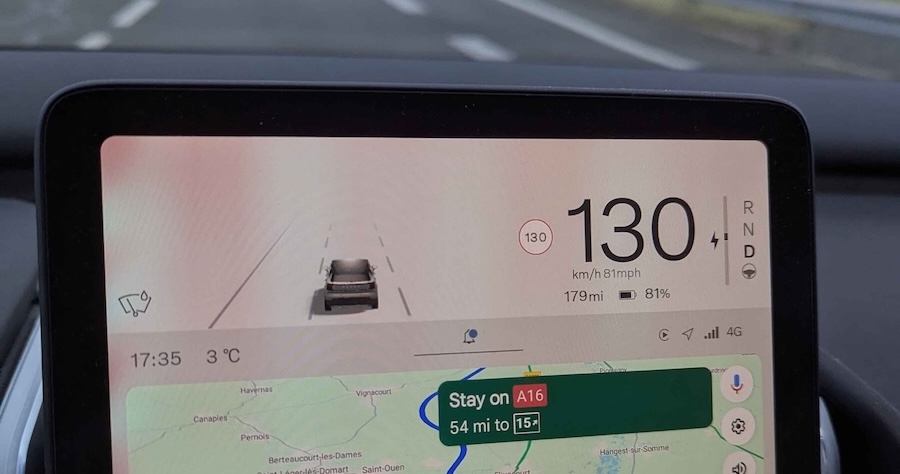At the start of February 2025 we took a trip to Disneyland Paris and decided to go by car rather than by plane. We have a Volvo EX30 and there doesn't seem to be much information available online about taking it to Europe, so I've written up what we discovered in the hope other EX30 owners find it useful.
Preparing the car beforehand
France has additional laws about things you must carry in your vehicle whenever you drive there, namely a warning triangle and a hi-vis vest for each passenger. I bought my EX30 new and it came with a warning triangle in the boot (in an orange case attached under the parcel shelf with velcro). I had to buy hi-vis vests since it did not come with any. Note that the vests have to be inside the car with you at all times, and cannot be stored in the boot.
Lists of items to take when driving in France always include headlight beam deflectors (to prevent usually left-pointing headlights from blinding oncoming traffic). However, speaking with Volvo Support, I was told this is not necessary for an EX30, since it has LED headlights that adjust automatically based on oncoming traffic. They will automatically avoid pointing directly into oncoming traffic, with no adjustment necessary.
If you intend to drive into Paris itself (which you don't have to do, if you're only going to Disneyland Paris), you also need a Crit'Air sticker that goes on the windscreen. Since the EX30 is an EV, you'll be sent a green sticker that allows you to enter any of the low emission zones in France. It costs about €5 and took around two weeks to arrive (so make sure you order it with plenty of time to spare). If you don't have one and enter a low emission zone, you can get an on-the-spot fine.
Driving in France
The obvious difference is that you drive on the right hand side of the road in France. Coming from the Eurotunnel it's impossible to drive on the incorrect side, since the exit road from the train takes you straight onto the A16 motorway.
The other important difference is that the speed limits are measured in km/h instead of mph. On the EX30 display you can switch the speedometer to km/h by going to Settings → System → Units and choosing it for the speed option. You can also switch to km for distances as well if you want (this will apply to things like the battery range estimate). When the car is set to km/h, the main speedometer display will switch to km/h but there will also be a small mph display below it so you can see what the equivalent is.

The car's built in mobile network connection works across Europe, and according to Volvo support this also includes the SOS button as well. We had no issues with Google Maps navigation displaying traffic information and road closures while in France. It also automatically updated the clock to the correct timezone on arrival.
Charging
There are DC fast chargers in the departure area of both Eurotunnel terminals, as well as Tesla superchargers. The Tesla chargers are available for use in non-Tesla cars (and are usually a bit cheaper per kWh), however there are rubber wheel stoppers in front of them in the Calais terminal, so I couldn't actually park close enough for the short Tesla cable to reach the charging port.
The route from the Eurotunnel to Disneyland Paris is around 320 km, or about 200 miles. Theoretically an EX30 could make the entire trip on a full charge, however driving at 130 km/h (the speed limit on French motorways) will probably reduce the range and make it harder.
We charged to around 90% in the Folkestone terminal before boarding the train, and used two DC rapid chargers on the way to Disney. We probably could have got away with only charging once, but we wanted to have some battery reserved for getting between Disney and the hotel.
On the way back, we charged to 100% right before leaving, and we only had to charge once on the way back to Calais.
There are a number of motorway services on the route between Calais and Disney, and they all seemed to have DC rapid chargers capable of 300 kW. Most of them accept contactless cards for payment, but they also allow use of RFID charge cards, such as the Electroverse card. We exclusively used an Electroverse card since we get a 5% discount as Octopus Energy customers. Every charger we stopped at was supported by Electroverse (unlike in the UK, where many chargers don't accept it).
Disneyland Paris
There isn't much to say about Disneyland Paris specifically regarding driving, except for one sneaky tip: instead of parking at the official Disneyland parking, which costs €30 per day, you can actually park at the multi-storey car park intended for Disney Village instead. Look for the "Indigo Charging Station" on Google Maps to get directions.
Not only is that car park closer to the theme parks, but as of writing it only costs €24 to park there for 24 hours, and there are 69 spaces with EV chargers. They're only 7 kW chargers, but if you're going to be parked there all day while you're at the theme parks then you should get pretty close to a full charge. It'll also cost about half as much as a rapid charger — we parked all day (around 10 hours) and went from around 30% to 100% for less than €20.